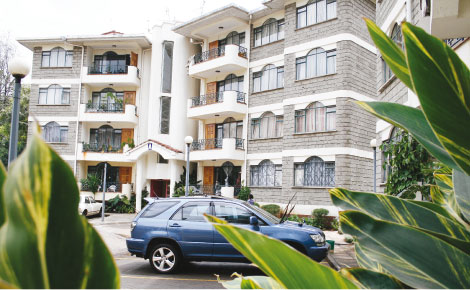
Kenya: A new report released last week paints a gloomy picture for the country’s real estate industry, with Nairobi to be hit most by a looming housing shortage, writes MKALA MWAGHESHA
An acute housing shortage is looming for Nairobi’s middle-class if the current real estate trends prevail, says a new report.
This is coming at a time when industry players are confessing that no one for sure knows the actual figures on housing demand in Nairobi and the entire country. Titled State of Development Report, the new report released last week jointly by the Kenya Property Developers Association (KPDA) and property firm HassConsult, paints a sorry state of the housing sector.
It notes that in 2013, only 15,000 houses were planned and approved for building, against a demand of 200,000 housing units per year. This translates to 7.5 per cent of the demand. But the report says this number is set to go down if the projected population and industry challenges prove difficult for developers to manoeuvre.
“Nairobi has declared its intention to emerge as a world class city, but this depends on a sharp increase in construction, where current trends are instead slowing down the development industry’s rate of growth,” said Robyn Emerson, KPDA CEO. “We (the private sector) are constantly engaging the central government to seek a solution to these challenges. The progress is slow but at least we are in discussion,” she said.
Many challenges have been cited for the housing deficit, with rising construction fees, lack of financing, lack of proper planning, lack of data and actual figures and the skyrocketing price of land mostly blamed.
Increased permit fees
In Nairobi County, the county government increased the construction permit fees from between 0.001 per cent and 0.006 per cent of the construction cost to 1.25 per cent. According to some developers, the increase was done without any consultations.
“I have been in a scenario where the financers of a development I was involved in were shocked when they were informed that the fees had gone up,” said Sam Manjau of Abec Real Estate. “They had already calculated everything and ready to start construction but I informed them to counter-check with the county government. The figures they received at City Hall shocked them and this led to re-planning of the entire project.”
The rising cost of construction and other costs associated with lack of proper infrastructure, which developers are forced to put up, have led to high costs of houses, which a big section of the intended market cannot afford.
“Most developers are forced to put up their own infrastructure to attract customers but they are happy to pass the costs incurred to the end user by selling houses at higher prices,” said Nathan Luesby, Jenga Web Managing Director.
High interest rates are part of the problem, ensuring only 22,000 mortgages in a country of about 42 million. Lack of affordable home loans is said to be the reason behind the rising demand for the rental market.
High interest rates have also forced many housing projects to be shelved, with intense development taking place in only a few suburbs — mainly in Kilimani and Embakasi — instead of the whole city.
Of the 15,000 planned houses built in 2013, 90 per cent were apartments. “It is because they are in demand. Also, the high cost of land has led to developers utilising the least amount of land to put up more units ‘upwards’ than spreading them horizontally,” said Luesby.
Stay informed. Subscribe to our newsletter
Sakina Hassanali of HassConsult concurred, saying that scarcity of land for development is changing how developers are now planning housing development. She said that as a company, they were finding it hard to do research on land due to its erratic pricing nature.
Lack of planning was said to be causing uneven development activity.
“There is an oversupply, especially in densely populated areas like Eastlands, because of lack of planning. Some developers are building flats because they are seeing other developers in the same locality doing the same,” said Mucai Kunyiha, Vice Chairman of KPDA. “So it becomes a concentration of housing developments at the same place.”
The middle-income class, which is most hit by the housing deficit, is increasing at a very fast rate. The housing gap is expected to hit a shortfall of 1.6 million units by 2030.
According to Koffi Klousseh, Principal Investment Officer at International Finance Corporation, there will be a need for better infrastructure to serve the growing population. “Increasing working class population and middle-income households growth will have a huge impact on the demand for access to and better quality of infrastructure services,” Klousseh said during the East African Property Investment Summit in Nairobi.
“The economy is stable and favourable for those in the middle-income bracket. Also, this category has the power to buy and rent houses and it is well spread across the country,” said Luesby.
The 200,000 housing deficit figure is also in for scrutiny, with the industry not sure if it is for Nairobi or the entire country. All eyes are on the government to give the correct figures on the housing situation.
ministry’s survey
“The ministry of housing did a housing survey in 2011 with the results expected to come out January of 2013. To date, the survey results have not been released. It would have provided definite figures of the true deficit and demand,” said Luesby.
With figures from 150,000 to 250,000 quoted when trying to estimate the housing demand in the country, planners and analysts have been handicapped.
Emerson explained that KPDA was pushing the government to release the actual figures from the survey.
Nairobi’s population is expected to hit five million by 2020, up from the current 3.5 million.
According to Kunyiha, the solution to the problem lies in restructuring the industry to ensure all aspects of the industry are at par with each other. “There is a need for a multi-faceted solution to address all these issues,” he said.
Coming up with a master plan and more planning by both the central and the county governments is also seen as a solution. “Planning makes a difference in controlling the migration of people. If there is proper planning across the country, there will be no need for everyone to scramble to come to Nairobi or any urban centres, and therefore cause the congestion that we are experiencing,” said Luesby.
On financing, Aly Khan Satchu, CEO of Rich Management, projects a flow of funds into the industry. Giving a presentation at the property summit, he said: “I expect that the capital markets will encourage asset-backed securities, REITs (Real Estate Investment Trusts) and other instruments, which will signi?cantly enhance capital ?ows into real estate.”
“Remittances, which I believe are signi?cantly undercounted at $1.2b (Sh10.2 trillion) annually, are a signi?cant and growing channel of fund s into real estate,” he noted.
At the moment, the industry is looking at the government to offer correct figures, proper infrastructure and planning directives and incentives to developers.
 The Standard Group Plc is a
multi-media organization with investments in media platforms spanning newspaper
print operations, television, radio broadcasting, digital and online services. The
Standard Group is recognized as a leading multi-media house in Kenya with a key
influence in matters of national and international interest.
The Standard Group Plc is a
multi-media organization with investments in media platforms spanning newspaper
print operations, television, radio broadcasting, digital and online services. The
Standard Group is recognized as a leading multi-media house in Kenya with a key
influence in matters of national and international interest.
 The Standard Group Plc is a
multi-media organization with investments in media platforms spanning newspaper
print operations, television, radio broadcasting, digital and online services. The
Standard Group is recognized as a leading multi-media house in Kenya with a key
influence in matters of national and international interest.
The Standard Group Plc is a
multi-media organization with investments in media platforms spanning newspaper
print operations, television, radio broadcasting, digital and online services. The
Standard Group is recognized as a leading multi-media house in Kenya with a key
influence in matters of national and international interest.










